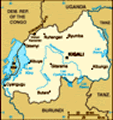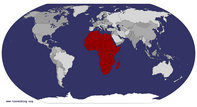Advertisement
Published: February 23rd 2009
I'm sitting on the floor of a seedy hotel room, feeling the vibration of the night club that we had no idea existed under our hotel. We are halfway through our time in Rwanda and we have not yet visited a genocide memorial site. I wanted to write this post tonight, before we visit the genocide museum here in Kigali tomorrow. Why? It all comes down to the Museum of the Native American in Washington D.C. When I visited there two years ago, I was powerfully struck by one thing about it. One thing that was very intentional on the parts of the curators (the curators were, by the way, selected from tribes throughout North America).
We've all been to museums in America that have the dioramas of the “noble savage” in buckskins and feathers. They have weaponry, dresses and pottery up the wahzoo, and the whole experience always ends up in that nook in the back of my mind reserved for ancient Egyptian sarcophogi, aztec blood-letting tools, and pictures of what prehistoric life “might” have been like for our hairy and heavy-browed ancestors. It's nice. We're expected to feel enriched by it. We can fantasize about what life would
have been like back then, and we even have idealized pictures and paintings to enhance whatever our imagination can come up with. But let me ask you - two days after being in that museum, do you really remember anything about it? Do you really care?
The Museum of the Native American was different for me for one reason. It is about now. What life is like for members of these first nations now. What do their economies rely on? What are the challenges confronting them? What broken treaties are they trying to gain recognition for now? How do they maintain or create identity now, when everybody dresses alike and the youth all listen to hip hop?
That is the piece that has been fascinating to me so far in Rwanda. Of course you can't be here without looking at everything through the lens of the genocide. Reminders are everywhere, and I've read too much about it not to be thinking about it constantly now that I am here. The thing is, though, Rwanda still exists. It is not frozen in time in 1994, even though the world's perception of it is. As we were driving through the
countryside a few days ago, Devin said “I expected to feel ghosts here, but it's not about ghosts. These people we see around us lived through it. They're still living their lives.” That's what I want to capture here before visiting the memorials - my impressions of the Rwanda of today which, frankly, has been totally surprising in a number of ways.
I expected Rwanda to be pretty much like Uganda. If anything, I expected it to be less developed. Boy was I wrong. We were immediately struck by it at the border. We had just driven the long way from Kabale to the crossing at Cyanika - 3 1/2 hours on a horrible dirt/rock road. On the Uganda side of the border, the immigration and police buildings, both of which you have to visit, are surrounded by garbage-strewn dirt and a bunch of people sitting idly around. The corresponding buildings on the Rwandan side are immaculate, with landscaped grounds and gravel paths leading to the windows where you get your documents stamped. Once cleared, you head south on perfectly smooth asphalt roads with lines down the middle, curbs on the sides, and culverts and drainage that would be
the envy of any Western country.
I thought my biggest road-related challenge would be remembering how to drive on the right side of the road, especially in my right-hand-drive car. The real challenge, though, was getting the hang of the social norms associated with driving here. First of all, there are rules and people follow them. In Uganda, you drive as fast as you possibly can in every situation, and pedestrians, bicyclists and boda boda drivers dive into the ditches when they hear you coming. If you need to go up on the sidewalk to get around somebody, you just do. I've kinda gotten used to that. Here in Rwanda, though, it is the cars that have to get out of the way when there is a pedestrian in the middle of the road (which is most of the time), and every time I start going above 80 km/hr people by the side of the road wave for me to slow down. People rarely pass each other, and the overall feeling is that driving here is mellow.
We have also been struck by the prosperity we see everywhere in the countryside. In most of Uganda, once you leave
the cities, people are living in mud huts with thatch roofs. In Rwanda, everywhere we look we see brick houses with shiny metal roofs and LUSH fields. The schools are very nice, and you come across trading centers frequently on the main roads. People are much better dressed than you see in the countryside of Uganda, and even far from the urban centers there is infrastructure like sidewalks, drainage and power lines. And you have to understand - even in Kampala, the capital of Uganda, you rarely find a curb, sidewalk or smooth road outside the downtown core.
Then we got into Kigali. I don't know what I expected, but this wasn't it. Again, I was really expecting Rwanda to be a lot like Uganda, so I expected Kigali to be like Kampala. Nope. Devin and I keep saying that we feel like we are in some city in Europe. Streets you can eat off of, sparkling new business buildings, stoplights, fancy cars, landscaping. Unbelievable.
The big question, then, is why Rwanda is more developed than Uganda in so many respects. Uganda has a much larger population (30 million versus 9 million), and has had 8 more years
of stability than Rwanda has had. My first thought was that there was so much genocide guilt that the international community just poured money into the country after 1994 and built everything up (and it is true, according to one article we read, that right after the genocide 100% of the Rwandan budget was donor money. Today, it is only 40% compared to 50% of Uganda's national budget). The more I thought about it, though, the more I realized there had to be more. There has to be buy-in on the part of the people, and lack of corruption in the government. It seems that everybody was ready for a fresh start after 1994, and it really sounds like Kagame has done a lot to root out corruption and that he sets a high bar for officials.
Even in the face of all these pleasant surprises, we still feel unsettled. We are used to Uganda, where people stare at you, but then when you wave you are met with a beaming smile and hearty wave in return. Here in Rwanda, if you wave the stares just get harder. There is an air of suspicion, and we always feel like
we are being watched. We might be projecting, and there is certainly a language-barrier in this non-English-speaking country that we don't have to deal with in Uganda. However, the meaning of a smile tends to be fairly universal and ours definitely don't seem to be welcome here.
Maybe we represent the international community that let this country down in such a serious way. Maybe they are wondering what we think of them and wonder if we are judging them for their past (I must admit that it is hard not to think about the fact that a lot of the people we see around us have killed some number of people with a machete). Maybe it is just the fact that this is a country of people suffering from post-traumatic stress disorder, whether a perpetrator or a victim. Whatever it is, we feel an edge here. Maybe we'll understand it more after visiting the memorial sites.
The highlight of our trip so far has been our camping trip in Nyungwe Forest National Park. A beautiful 1,000 square kilometer forest crossing the border between Rwanda and Burundi. It is the largest Afro-montane forest left in Africa, hosts 12 or
13 species of primates, and a bunch of endemic birds and other fauna. It was beautiful, and it felt good to camp. We even got to hear the haunting call of the tree hyrax in the night. As with everything else in Rwanda, though, it was shockingly expensive. $40/night for a campsite and $60 for a guided walk (and you are not allowed to walk alone). It's good to support the parks, but our cash is running a bit low since the “budget” hotels in Kigali all cost more than $50/night, meals at a dive cost as much as the best restaurants in Kampala, gas is about $7/gallon, etc. Once again, not what we expected.
I'll bring this to a close for now. Stay tuned for Part 2 after we've visited the memorials.
Advertisement
Tot: 0.176s; Tpl: 0.028s; cc: 8; qc: 23; dbt: 0.0907s; 1; m:domysql w:travelblog (10.17.0.13); sld: 1;
; mem: 1.1mb

















Pam
non-member comment
Smiles
Love you blog about Rwanda. I do have to say after visiting Rwanda 3 times, I have to dissagree about the smiles. I have almost always received a smile in return when I gave one. Of course saying Muraho helped! thanks